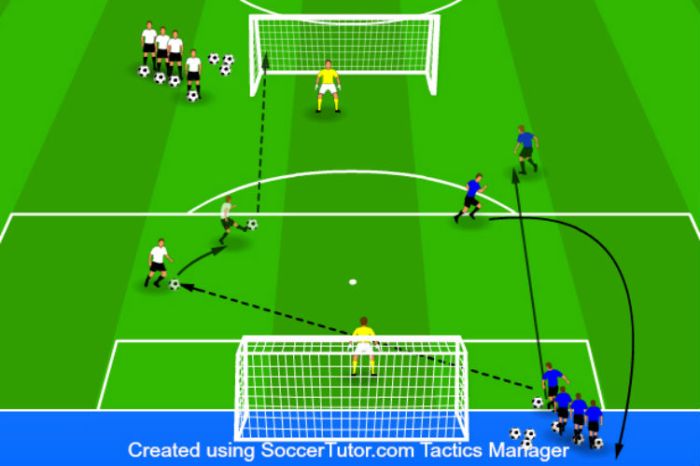Football goal-scoring drills are essential for honing your skills and dominating the game. Whether you’re a beginner looking to improve or an advanced player aiming for perfection, these drills will take your goal-scoring abilities to the next level. Get ready to elevate your game with precision and finesse!
Are you ready to unleash your scoring potential? Let’s dive into the world of football goal-scoring drills and unlock your true talent on the field.
Choosing the Right Drills
When it comes to goal-scoring drills in football, it is crucial to select the right ones that cater to the specific needs of the team. Different types of drills target various skills, and incorporating a variety of drills can help players develop a well-rounded skill set.
Types of Goal-Scoring Drills
- Finishing Drills: These drills focus on improving a player’s ability to score goals from different positions on the field.
- Crossing and Heading Drills: These drills help players work on their timing and accuracy when finishing crosses with headers.
- One-on-One Drills: These drills simulate game-like scenarios where a player has to beat a defender and score against the goalkeeper.
Importance of Variety in Drills
- Targeting Different Skills: By incorporating a variety of drills, players can work on different aspects of goal-scoring such as shooting, positioning, and decision-making.
- Keeping Players Engaged: Switching up drills regularly can help maintain player interest and motivation during training sessions.
Tailoring Drills to Team’s Needs
- Assess Team Weaknesses: Identify areas where the team is struggling in terms of goal-scoring and tailor drills to address these weaknesses.
- Focus on Team Dynamics: Consider the playing style and strengths of the team when selecting drills to ensure they align with the overall strategy.
Drill Setup and Equipment
When setting up goal-scoring drills in football, it is crucial to have the right equipment and an effective setup to ensure the drills are conducted smoothly and safely.
Essential Equipment
- Soccer balls
- Cones or markers
- Goals or target nets
- Bibs or jerseys to differentiate teams
- Whistles for coaches
- First aid kit
- Water bottles for hydration
Ideal Setup
For an effective goal-scoring drill, it is important to have a clear and organized setup. Here are some key points to consider:
- Mark out a playing area with cones or markers to define boundaries.
- Set up goals or target nets at both ends of the field.
- Divide players into teams and assign bibs or jerseys to differentiate them.
- Position coaches strategically around the field to provide guidance and feedback.
- Ensure there is enough space for players to move around freely and practice their shooting skills.
Safety Measures
While setting up goal-scoring drills, safety should always be a top priority. Here are some safety measures to consider:
- Inspect the playing area for any hazards or obstacles that could cause injuries.
- Ensure all equipment is in good condition and properly set up to prevent accidents.
- Encourage players to warm up and stretch before starting the drills to reduce the risk of injuries.
- Provide access to water and encourage players to stay hydrated throughout the session.
- Have a first aid kit readily available in case of any injuries or emergencies.
Skill Development: Football Goal-scoring Drills

When it comes to soccer, goal-scoring drills play a crucial role in enhancing players’ overall skill set. These drills not only improve shooting accuracy and speed but also help in developing agility and reaction time on the field.
Shooting Accuracy vs. Speed
- Improving shooting accuracy involves focusing on technique, body positioning, and precision when striking the ball towards the goal. Drills like target practice, shooting from different angles, and working on finishing techniques can help players become more precise in front of the goal.
- On the other hand, drills for speed focus on quick decision-making, explosive movements, and rapid execution of shots. Exercises like one-touch finishing, fast break scenarios, and timed shooting drills can help players increase their shooting speed and efficiency.
Enhancing Agility and Reaction Time
- Agility drills involve exercises that require players to change direction quickly, maintain balance, and move fluidly around obstacles. Cone drills, ladder drills, and shuttle runs are effective in improving players’ agility on the field.
- Reaction time drills aim to sharpen players’ responsiveness to sudden game situations, such as intercepting passes, deflecting shots, or making quick decisions under pressure. Activities like reaction ball drills, small-sided games, and simulated game scenarios can help players react faster and more effectively during matches.
Progression and Difficulty Levels
To ensure that players continue to improve and stay engaged, it’s crucial to have a well-thought-out progression plan for goal-scoring drills. By gradually increasing the difficulty level, players are challenged to push their limits and enhance their skills. Here are some tips on designing a progression plan and modifying drills to suit different skill levels within the team.
Progression Plan, Football goal-scoring drills
- Start with basic shooting drills focusing on technique and accuracy.
- Progress to more dynamic drills involving movement and decision-making.
- Incorporate game-like scenarios to simulate real match situations.
- Add pressure from defenders or time constraints to increase difficulty.
Modifying Drills
- Adjust the size of the playing area based on skill level – smaller for beginners, larger for advanced players.
- Vary the number of defenders or teammates involved in the drill to create different levels of challenge.
- Introduce restrictions such as using only one touch or shooting with a weaker foot to add complexity.
- Provide progressions for players to advance to once they have mastered the basic drill.
